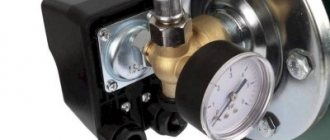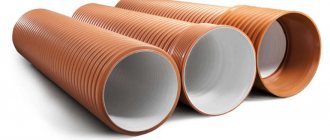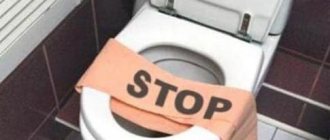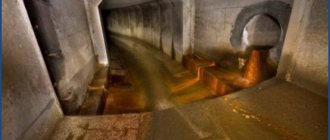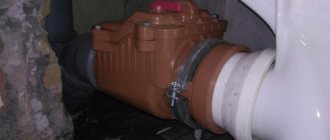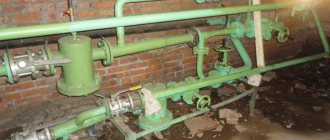Types of sewer clogs
If the sewer system in a house is operated in violation of all the rules for its use, then over time, blockages and plugs inevitably appear in the collector, which impede or completely stop the flow of wastewater. As a result, either someone from an apartment building or the owners of a private building will suffer from at least an unpleasant odor in the living space. The maximum possible flooding of the kitchen or bathroom with fecal water. This is not very pleasant, so to avoid such situations you need to use the collector correctly, namely:
- It is strictly forbidden to flush used personal hygiene items, such as pads, diapers, tampons, etc., down the toilet. Only flushing toilet paper is allowed.
- It is prohibited to flush bulk construction mixtures such as cement, sand, chalk, clay, etc. down the drain.
- Accidental flushing of rags and other similar items down the drain should be avoided.
- It is advisable to install grease traps in the kitchen, which will prevent the deposition of heavy greasy deposits on the walls of the collector. This, in turn, can create fecal growths-stalactites in the system and impede the flow of gray water.
Important: if there are malfunctions in the sewer system in a private or apartment building, you should not solve the problem yourself. It is better to invite a specialist who will determine the location of the traffic jam and eliminate it.
It is always worth remembering that a traffic jam can form either in a specific place in the sewer system in an apartment or in a private house, or at any point in the central riser. If the last option is checked, then the drains will have nowhere to go but to return back from the blockage under the influence of hydraulic force. As a result, fecal or gray water will try to escape through the unoccupied openings of the bathtub, sink, and other plumbing fixtures.
How to eliminate air lock in sewer pipes
It happens that the sewage system of an apartment or private house is installed correctly, but the problem is that from time to time, after a volley of water drainage, unpleasant odors disturb you in the forge or bathtub. And it is impossible to get rid of them, even by closing the toilet lid or sink drain. What it is and how to troubleshoot communication problems is discussed below.
If the sewer system in a house is operated in violation of all the rules for its use, then over time, blockages and plugs inevitably appear in the collector, which impede or completely stop the flow of wastewater. As a result, either someone from an apartment building or the owners of a private building will suffer from at least an unpleasant odor in the living space. The maximum possible flooding of the kitchen or bathroom with fecal water. This is not very pleasant, so to avoid such situations you need to use the collector correctly, namely:
- It is strictly forbidden to flush used personal hygiene items, such as pads, diapers, tampons, etc., down the toilet. Only flushing toilet paper is allowed.
- It is prohibited to flush bulk construction mixtures such as cement, sand, chalk, clay, etc. down the drain.
- Accidental flushing of rags and other similar items down the drain should be avoided.
- It is advisable to install grease traps in the kitchen, which will prevent the deposition of heavy greasy deposits on the walls of the collector. This, in turn, can create fecal growths-stalactites in the system and impede the flow of gray water.
Important: if there are malfunctions in the sewer system in a private or apartment building, you should not solve the problem yourself. It is better to invite a specialist who will determine the location of the traffic jam and eliminate it.
It is always worth remembering that a traffic jam can form either in a specific place in the sewer system in an apartment or in a private house, or at any point in the central riser. If the last option is checked, then the drains will have nowhere to go but to return back from the blockage under the influence of hydraulic force. As a result, fecal or gray water will try to escape through the unoccupied openings of the bathtub, sink, and other plumbing fixtures.
In order to try to remove a blockage in the sewer drain of an apartment or house, you must first determine the location of the blockage.
- So, if a problem with water outflow is observed in the kitchen sink, and all other drain points are working normally, it means that the garbage plug has formed specifically in the siphon under the sink. In the same way, you can identify blockages under the sink in the bathtub or under the bathtub/shower stall itself. Depending on the location of the plug, chemicals such as “Mole”, etc., can be poured into the drain hole in accordance with the instructions and eliminate the problem of deposits on the pipes.
Important: if the pipes in the bathrooms and kitchen are still old cast iron, then such aggressive drugs will only be a temporary measure. Plaque inside a cast iron manifold will still bring a lot of trouble, which means that it is better to change the pipeline to a plastic one.
- As an aggressive anti-clog agent, you can use simple soda mixed with hot water. That is, first pour soda into the hole in the bathtub or sink, then fill it with hot water. After this, vinegar is poured into the hole. The reaction of the components should push the plug or simply liquefy it.
- You can also use a standard plunger to remove a blockage in your home drain. Cleaning is easy with it. You need to fill the plumbing fixture with water and tightly cover the drain hole with a plunger. Now you should make rhythmic movements up and down with the plunger, creating a vacuum in the manifold. Under its influence, the plug should either come out (most often it is hair) or go into the waste system. You can clean the sink and toilet in a similar way.
Important: if water does not drain well at all plumbing points, then most likely the problem is rooted in the common riser. In this case, you can try to carefully guide a steel wire with a hard brush tip into the system, but it is better to call a professional plumber.
If the above cleaning methods do not help and the water also slowly flows into the collector, creating unpleasant odors in the system, you can invite specialists to flush the collector using a hydrodynamic method. In this case, special equipment is used that supplies water to the system under high pressure. Thanks to the high power of the supplied jet, the collector is cleared of all plugs and blockages. It is fashionable to clean pipes with a diameter of 5 to 100 mm in this way.
Important: you can also use a similar technology for cleaning the system in an apartment. But it is necessary to invite specialists who have the appropriate equipment.
An air lock formed in the sewer system of a house can also disable the operation of the sewer collector. The air that has stopped in the system simply prevents the drains from leaving through the riser and either returns them back or passes them through, but very slowly and at the same time throws sharp unpleasant odors into the room.
The reasons for the formation of an air lock in the sewer can be as follows:
- Mistakes made when installing a plastic manifold (insufficient tightness of the pipeline, lack of connecting fittings, etc.);
- Excessive manifold turns, incorrect pipeline drops or incorrectly selected elbow angles;
- Lack of a water seal in the installed sewage system;
- Possible blockage or icing of the drain pipe in the attic or roof area.
You can solve the air lock problem yourself. The main thing is to identify the reason for its formation.
- First, it is worth inspecting the pipeline along its entire length for cracks or depressurization (provided that the sewerage system has a water seal). If any are found, it is worth replacing the collector section with a whole one. In this case, the air will freely flow into the drain pipe during a volley discharge of water into the system. That is, the water seal cover will close when the pressure in the pipeline increases and thereby prevent stagnation of water.
- If an air lock is observed in the area of a specific plumbing fixture, then perhaps the slope of the pipes towards the riser was not observed during installation. To do this, you need to reposition the pipeline section to create the required slope or, if possible, raise the plumbing fixture to create the optimal level of slope for the drains.
- If the sewerage system basically does not have a drain pipe, then it will have to be installed with the installation of water seals near each plumbing fixture.
Important: for bathtubs and sinks there are special vacuum valves of small diameter, which are designed to make the work of the collector productive.
- It is possible that the plumbing fixture is located too far from the riser. In this case, a plug of air could also form. Here it is better to invite a specialist who will lay out the pipe in compliance with all installation rules.
And always remember that if you are not confident in your abilities and think that you are prone to make mistakes when installing sewerage in your home, it is better to use the services of professionals. The craftsmen will create a reliable drainage system with a properly functioning drain pipe,
Help us become better, evaluate the presentation of the material and the work of the author
Most often, clogged sewer systems occur in old houses, and the reasons for this phenomenon can be completely different. For example, due to the owner’s negligence, a rag or some hard object may get stuck in the system. Over time, the diameter of the pipe narrows as fat deposits form on its walls. Therefore, a minor blockage can cause a big problem. Depending on the nature of the problem, there are several solutions that can be used to effectively clean the sewer with your own hands without calling a professional.
All sewer blockages are divided into several types:
- adhesion of fat to the internal surfaces of the pipe and adhesion of other waste. Such a blockage is usually called operational;
- the mechanical appearance differs from the previous one in that the cause of clogging is the entry of a foreign object into the system;
- as a result of the appearance of a fatty layer, a siphon blockage may occur;
- There is also a man-made problem, the cause of which is an error during installation of the system.
Attention! Before attempting to fix the problem, you first need to determine the specific location of the blockage. To do this, all risers are checked, and this particularly applies to the bathroom and kitchen. The work of the bathtub itself, toilet, shower and kitchen sink must be assessed. In rare cases, the main drain pipe may become clogged.
If the main access riser on the lower floor becomes clogged, then all the contents in the pipe rise up and come out in someone’s toilet, bathroom or kitchen. In such situations, you need to urgently call a specialist, since it is unlikely that you will be able to fix the problem yourself.
finding an air lock in a sewer pipe
There are many different tips and recommendations on how to clean a drain in a toilet or bathroom, but it is better to pay attention to the main and most effective ones:
- You can use regular soda to clean drains. To dilute the correct solution, you need to prepare several liters of boiling water in which a pack of soda will dissolve. The prepared liquid should be poured into the drain hole, and it is recommended to gradually add vinegar. In this way, a reaction can be achieved that will facilitate the rapid decomposition of fat. Most often, this method is used if there are no special means at hand, which include Mole, Tiret, etc.
- You can use chemicals yourself, but it is important to follow basic safety rules. Immediately before cleaning the sink, toilet or bathtub, you need to familiarize yourself with the operating instructions for a particular product. It is better to use this cleaning method when the pipe is not yet completely clogged, this way you can achieve greater efficiency. When the drain is completely clogged, it is dangerous to use chemicals because they can back up into the bathtub or sink.
- A proven and reliable method of cleaning is to use a simple plunger. When actions using soda or chemicals do not bring much effect, then this method can be used. In such cases, it is important that the bowl of the plunger completely covers the drain hole.
Actions are performed in a certain sequence:
- a sample filter is removed from the hole;
- the top hole of the bathroom must be tightly closed to achieve greater efficiency during the work process;
- The plunger must be installed so that no air lock appears, while the handle is placed vertically;
- without lifting the device from the bottom of the bathtub, you need to move the device up and down;
- on the last movement, the plunger rises from the water to check the effectiveness of its drainage. If necessary, the procedure is repeated several more times.
Another proven device is a metal cable, which is often used by plumbers. At one end of such an object there are fluffy wires, on the other side of the cable there is a handle for convenient use. The first end is inserted into the pipe, and rotational movements must be made using the handle. Depending on the degree of pipe clogging and the location of the problem, cleaning can take a relatively long time. If the problem is solved quickly, then the length of the cable is sufficient to effectively penetrate the sewer.
Removing a drain plug using a plunger
If all known means are ineffective, it is recommended to use a special technical device with which hydrodynamic cleaning is carried out. This method is considered very effective.
Such machines differ in power and overall dimensions. It is allowed to clean pipes whose diameter can be 5-100 cm.
the principle of cleaning pipes using a hydrodynamic method
As a rule, all hydrodynamic devices operate on the same principle, regardless of their power and size. A nozzle is put on the end of the device, through which a stream of water is supplied under high pressure. The flexible hose ensures maneuverability of the device, which is important for achieving a positive result.
After cleaning sewer pipes using the hydrodynamic method, subsequent maintenance or additional treatment will not be required soon.
Some people often wonder whether it is possible to use such equipment at home and what are the costs? In answering these questions, it should be noted that to clean the sewer system in an apartment it is not necessary to buy special equipment. It’s easier to call a specialized organization. If there is a need or your financial situation allows, you can buy a mini-device for use in a country house.
Nowadays, plastic pipes are very popular, which are distinguished not only by good performance characteristics, but also by easy installation. Not everyone who installs plastic pipes is a specialist, so when choosing consumables for installing a sewer system, various types of mistakes can be made. Common mistakes when choosing and installing a system include:
- incorrect determination of pipe diameter;
- unnecessary turns during the installation process;
- laying sewer pipes at the freezing level of the ground;
- lack of means in large areas to control the operation of the system.
The last point is often the cause of blockages. Also, sewerage can freeze in the winter. The appearance of both fat and air plugs is often observed.
The most difficult issue to resolve is that of an air lock in the sewer; not everyone knows how to fix this problem. If it is serious enough, then there may be a need to rebuild the entire sewer system. Before making such drastic decisions, you need to try to eliminate the problem yourself, using some simple methods.
removing an air lock from a sink drain pipe
If an air lock appears in a specific section of the pipe, for example, in the sink drain in the kitchen, bathroom or toilet, the essence of the problem may be:
- in the farthest location of the plumbing fixture from the riser;
- due to an installation error when pipes were installed with the wrong slope.
To solve such problems, you can simply re-lay the sewer sample to the riser, taking into account the correct level of inclination. In some situations, it is enough to simply raise the plumbing fixture to the required level. Thus, due to the level difference, you can get rid of problems with an air lock.
If there is an air lock in every plumbing fixture, then most likely the design of the air duct was not thought through during the installation of the system. In such a situation, it is recommended to make an open sewer riser on the roof, through which air is released from the pipeline. If this is not possible, you can install air valves that can allow air to flow in one direction.
There are situations when an air lock forms during the installation of an air duct. Then you need to check its performance.
If the measures taken to eliminate the air lock in the sewer are not successful, then the only solution is to lay new pipes.
We were very fond of flushing personal hygiene products down the drain, which regularly created a blockage. Over time, it began to clog more and more often, in the end they resorted to the help of our plumber, who said that the problem was precisely because of this. Now it seems like a section of the pipe has been completely replaced, it’s gotten better, but people still don’t care how many advertisements were written with requests, they don’t give a damn.
We were very fond of flushing personal hygiene products down the drain, which regularly created a blockage. Over time, it began to clog more and more often, in the end they resorted to the help of our plumber, who said that the problem was precisely because of this. Now it seems like a section of the pipe has been completely replaced, it’s gotten better, but people still don’t care how many advertisements were written with requests, they don’t give a damn.
Ways to fix sewer problems
In order to try to remove a blockage in the sewer drain of an apartment or house, you must first determine the location of the blockage.
Causes of sewer gurgling and their elimination
- So, if a problem with water outflow is observed in the kitchen sink, and all other drain points are working normally, it means that the garbage plug has formed specifically in the siphon under the sink. In the same way, you can identify blockages under the sink in the bathtub or under the bathtub/shower stall itself. Depending on the location of the plug, chemicals such as “Mole”, etc., can be poured into the drain hole in accordance with the instructions and eliminate the problem of deposits on the pipes.
Important: if the pipes in the bathrooms and kitchen are still old cast iron, then such aggressive drugs will only be a temporary measure. Plaque inside a cast iron manifold will still bring a lot of trouble, which means that it is better to change the pipeline to a plastic one.
- As an aggressive anti-clog agent, you can use simple soda mixed with hot water. That is, first pour soda into the hole in the bathtub or sink, then fill it with hot water. After this, vinegar is poured into the hole. The reaction of the components should push the plug or simply liquefy it.
- You can also use a standard plunger to remove a blockage in your home drain. Cleaning is easy with it. You need to fill the plumbing fixture with water and tightly cover the drain hole with a plunger. Now you should make rhythmic movements up and down with the plunger, creating a vacuum in the manifold. Under its influence, the plug should either come out (most often it is hair) or go into the waste system. You can clean the sink and toilet in a similar way.
Important: if water does not drain well at all plumbing points, then most likely the problem is rooted in the common riser. In this case, you can try to carefully guide a steel wire with a hard brush tip into the system, but it is better to call a professional plumber.
What kind of blockages can there be and how to determine their cause?
All sewer blockages are divided into several types:
- adhesion of fat to the internal surfaces of the pipe and adhesion of other waste. Such a blockage is usually called operational;
- the mechanical appearance differs from the previous one in that the cause of clogging is the entry of a foreign object into the system;
- as a result of the appearance of a fatty layer, a siphon blockage may occur;
- There is also a man-made problem, the cause of which is an error during installation of the system.
Attention! Before attempting to fix the problem, you first need to determine the specific location of the blockage. To do this, all risers are checked, and this particularly applies to the bathroom and kitchen. The work of the bathtub itself, toilet, shower and kitchen sink must be assessed. In rare cases, the main drain pipe may become clogged.
If the main access riser on the lower floor becomes clogged, then all the contents in the pipe rise up and come out in someone’s toilet, bathroom or kitchen. In such situations, you need to urgently call a specialist, since it is unlikely that you will be able to fix the problem yourself.
Finding an air lock in a sewer pipe
Ways to solve the problem
- You can use regular soda to clean drains. To dilute the correct solution, you need to prepare several liters of boiling water in which a pack of soda will dissolve. The prepared liquid should be poured into the drain hole, and it is recommended to gradually add vinegar. In this way, a reaction can be achieved that will facilitate the rapid decomposition of fat. Most often, this method is used if there are no special means at hand, which include Mole, Tiret, etc.
- You can use chemicals yourself, but it is important to follow basic safety rules. Immediately before cleaning the sink, toilet or bathtub, you need to familiarize yourself with the operating instructions for a particular product. It is better to use this cleaning method when the pipe is not yet completely clogged, this way you can achieve greater efficiency. When the drain is completely clogged, it is dangerous to use chemicals because they can back up into the bathtub or sink.
- A proven and reliable method of cleaning is to use a simple plunger. When actions using soda or chemicals do not bring much effect, then this method can be used. In such cases, it is important that the bowl of the plunger completely covers the drain hole.
How to fix the problem using a plunger?
Actions are performed in a certain sequence:
- a sample filter is removed from the hole;
- the top hole of the bathroom must be tightly closed to achieve greater efficiency during the work process;
- The plunger must be installed so that no air lock appears, while the handle is placed vertically;
- without lifting the device from the bottom of the bathtub, you need to move the device up and down;
- on the last movement, the plunger rises from the water to check the effectiveness of its drainage. If necessary, the procedure is repeated several more times.
Another proven device is a metal cable, which is often used by plumbers. At one end of such an object there are fluffy wires, on the other side of the cable there is a handle for convenient use. The first end is inserted into the pipe, and rotational movements must be made using the handle. Depending on the degree of pipe clogging and the location of the problem, cleaning can take a relatively long time. If the problem is solved quickly, then the length of the cable is sufficient to effectively penetrate the sewer.
Removing a drain plug using a plunger
Hydrodynamics for sewer cleaning
If the above cleaning methods do not help and the water also slowly flows into the collector, creating unpleasant odors in the system, you can invite specialists to flush the collector using a hydrodynamic method. In this case, special equipment is used that supplies water to the system under high pressure. Thanks to the high power of the supplied jet, the collector is cleared of all plugs and blockages. It is fashionable to clean pipes with a diameter of 5 to 100 mm in this way.
The official application from the bookmaker 1xBet is absolutely free and you can click on the link and place bets on sports.
Important: you can also use a similar technology for cleaning the system in an apartment. But it is necessary to invite specialists who have the appropriate equipment.
Danger of air bubbles in the pipeline
Bubbles, especially large ones, can destroy even strong elements of the highway. The main troubles they cause to owners of private houses:
- They accumulate in the same areas, leading to breakdowns of pipe sections and adapters. They also pose a risk for turning and twisting pipe sections where air is trapped.
- They break the water flow, which is inconvenient for the user. The taps “spit out” water all the time and vibrate.
- Causes water hammer.
Water hammer leads to the formation of longitudinal cracks, which causes the pipes to gradually collapse. As time passes, the pipe breaks at the point of cracking and the system stops functioning.
Therefore, it is important to equip additional elements that allow you to quickly get rid of dangerous bubbles
Air lock is the cause of stagnation of drains
An air lock formed in the sewer system of a house can also disable the operation of the sewer collector. The air that has stopped in the system simply prevents the drains from leaving through the riser and either returns them back or passes them through, but very slowly and at the same time throws sharp unpleasant odors into the room.
The reasons for the formation of an air lock in the sewer can be as follows:
Sewage cleaning using the hydrodynamic method
- Mistakes made when installing a plastic manifold (insufficient tightness of the pipeline, lack of connecting fittings, etc.);
- Excessive manifold turns, incorrect pipeline drops or incorrectly selected elbow angles;
- Lack of a water seal in the installed sewage system;
- Possible blockage or icing of the drain pipe in the attic or roof area.
Fixing the problem
You can solve the air lock problem yourself. The main thing is to identify the reason for its formation.
- First, it is worth inspecting the pipeline along its entire length for cracks or depressurization (provided that the sewerage system has a water seal). If any are found, it is worth replacing the collector section with a whole one. In this case, the air will freely flow into the drain pipe during a volley discharge of water into the system. That is, the water seal cover will close when the pressure in the pipeline increases and thereby prevent stagnation of water.
- If an air lock is observed in the area of a specific plumbing fixture, then perhaps the slope of the pipes towards the riser was not observed during installation. To do this, you need to reposition the pipeline section to create the required slope or, if possible, raise the plumbing fixture to create the optimal level of slope for the drains.
- If the sewerage system basically does not have a drain pipe, then it will have to be installed with the installation of water seals near each plumbing fixture.
Important: for bathtubs and sinks there are special vacuum valves of small diameter, which are designed to make the work of the collector productive.
- It is possible that the plumbing fixture is located too far from the riser. In this case, a plug of air could also form. Here it is better to invite a specialist who will lay out the pipe in compliance with all installation rules.
And always remember that if you are not confident in your abilities and think that you are prone to make mistakes when installing sewerage in your home, it is better to use the services of professionals. The craftsmen will create a reliable drainage system with a properly functioning drain pipe,
Installation
It is mandatory to install an air valve on the sewer in buildings with a height of more than 1 floor. An alternative to the installation would be to place ventilation shafts throughout the entire space of the house and provide feedback to all plumbing fixtures and ventilation. Installing an air aerator is much easier.
Actually, its installation should be carried out in a special socket of the sewer pipe. For aesthetic reasons, you can place the pipe with it in the wall, covering it with a ventilation grill. Direct access to it is required for possible repairs , replacement or maintenance work. A pipe with a socket for installing a ventilation valve is additionally installed in the sewer system.
If the drain pipe has a connection to the roof, but it is not enough, an air valve can be installed directly in the room, next to the appliances.
The temperature in the room in which it is installed must be above 0 degrees.
The simplest and most reliable installation is at the end of the sewer pipe.
Advice. In what cases is it advisable to install a valve? When waste is introduced into the sewer system under pressure, for example when installing an automatic washing machine. The rate of waste supply is much faster than with gravity flow and fan vents do not always cope with the air supply. You probably heard simultaneous bubbling in the water seals? Installing an aerator will solve the problem.
When installing an air valve on a horizontal sewer section, be sure to check the direction of movement. The arrow on the body indicates the actual direction of the wastewater, not the air flow.
The role of air in the operation of the sewer system
When you flush water in an apartment building, the liquid immediately goes into a vertical riser. A properly functioning sewer system does not gurgle. A person hears only the sound of water and nothing else. Unfortunately, many people perceive extraneous noise as something normal. Weeks and even months pass before a person turns to a plumber for help. Statistics show that delay in this case leads to an increase in the cost of repair work.
Sewerage in the kitchen or toilet is arranged identically. The constant flow of air creates a pressure difference. As the wastewater discharges, it more actively rushes to the exit. If a “traffic jam” is formed at any stage, a specific sound immediately appears. As soon as “gurgling” sounds begin to be heard from the toilet or sink, you should immediately call a plumber.
How does education happen?
The correct start of the heating system is one in which it is filled through the return line using a make-up pump. When filling the system through the return line, the filling process is performed from the bottom up, the coolant gradually begins to fill all pipelines and heating devices, and excess air rises. As a result, it is very easy to drain it from the system using air collectors located at the highest points.
However, the process, sequence and incorrect start-up are not the only reasons why an air lock forms in the heating system. During operation of the heating system, air is sucked in through flange and threaded connections, as well as other existing leaks, which leads to the formation of a plug.
